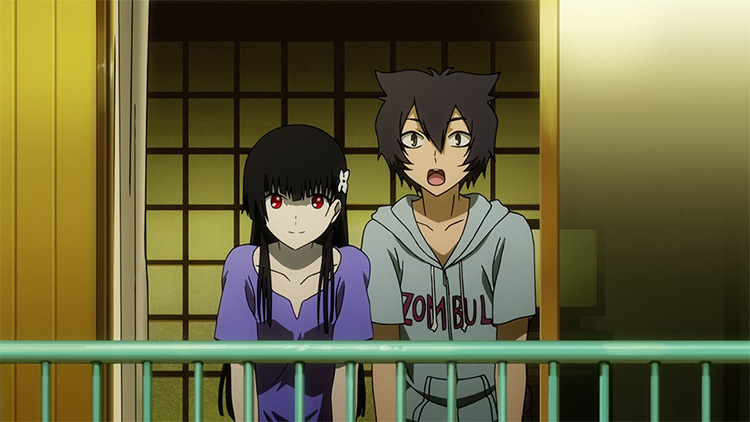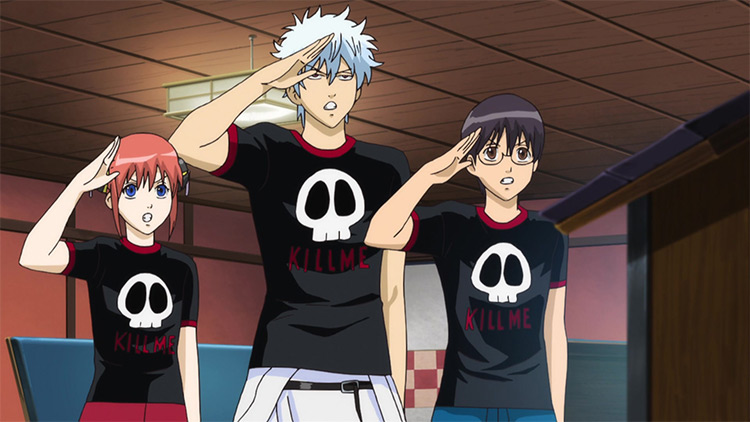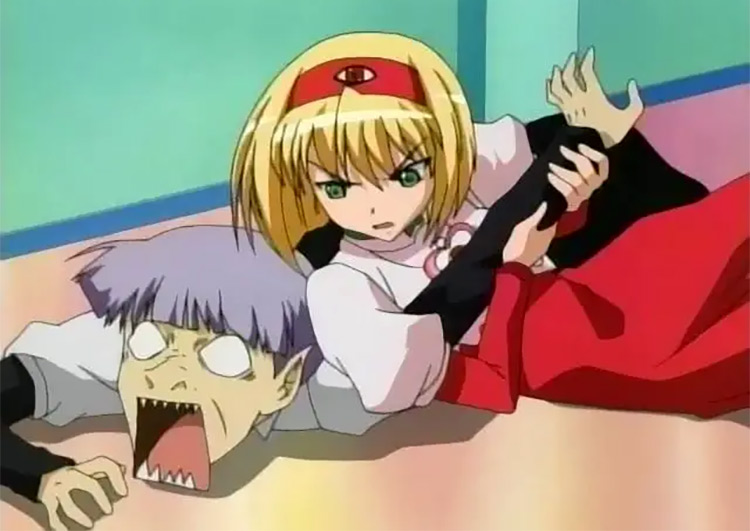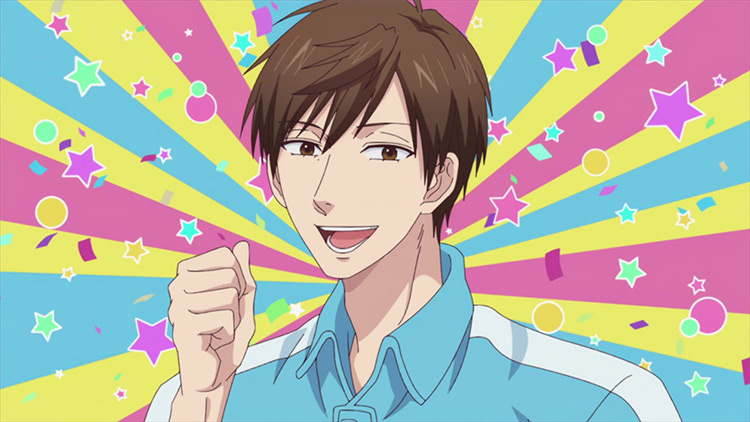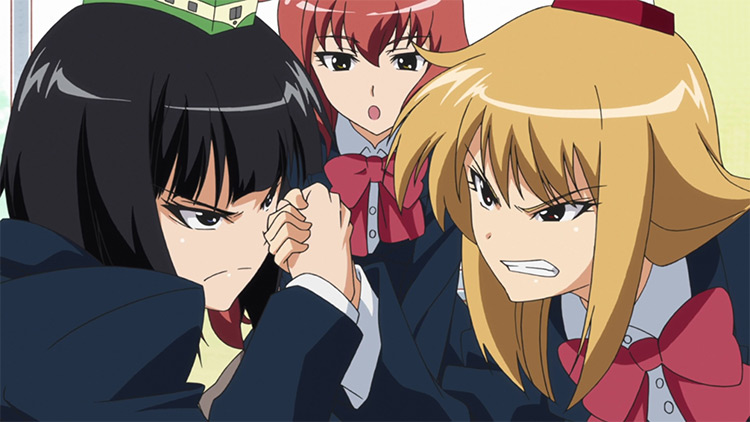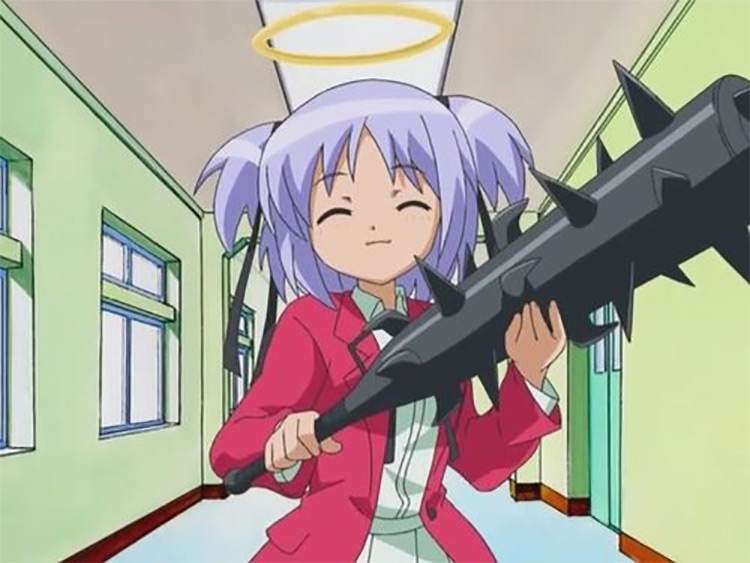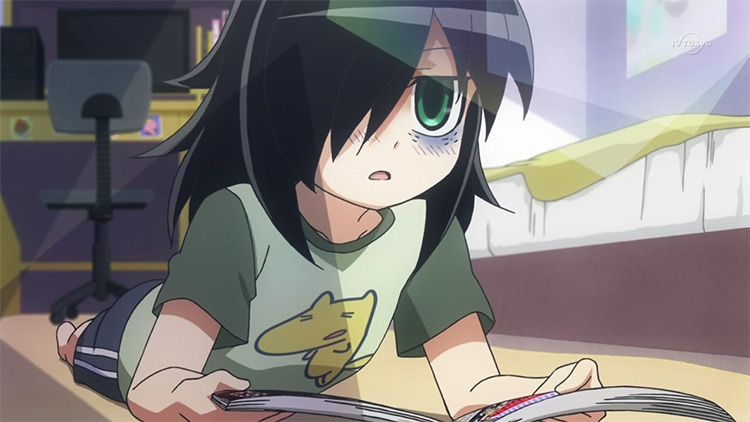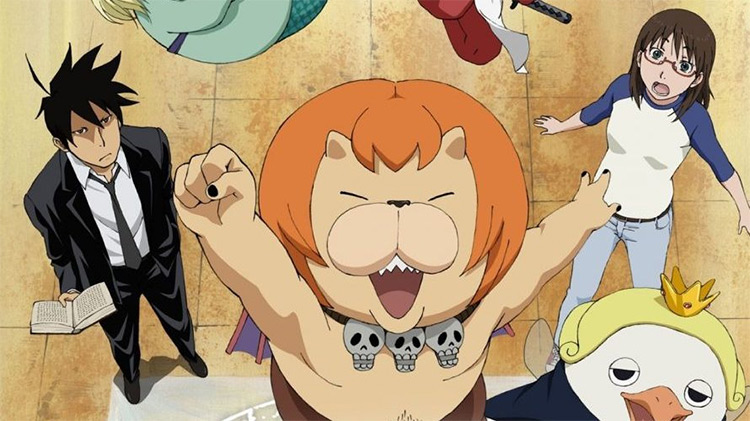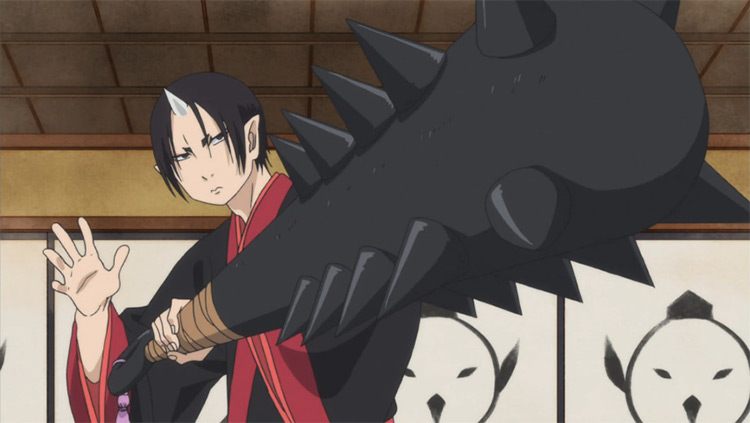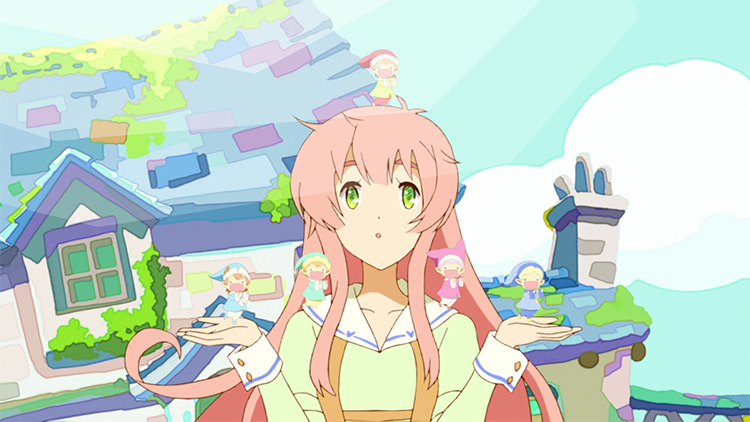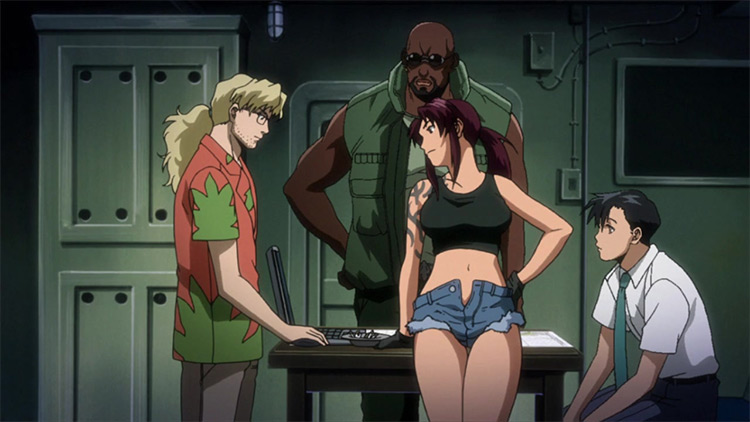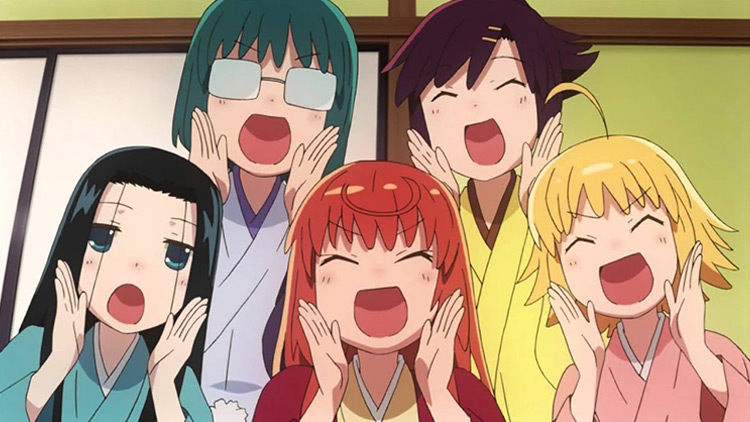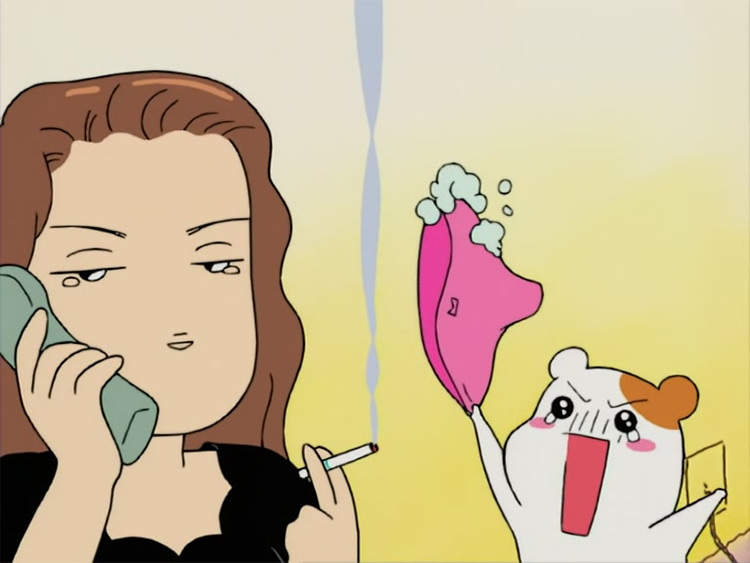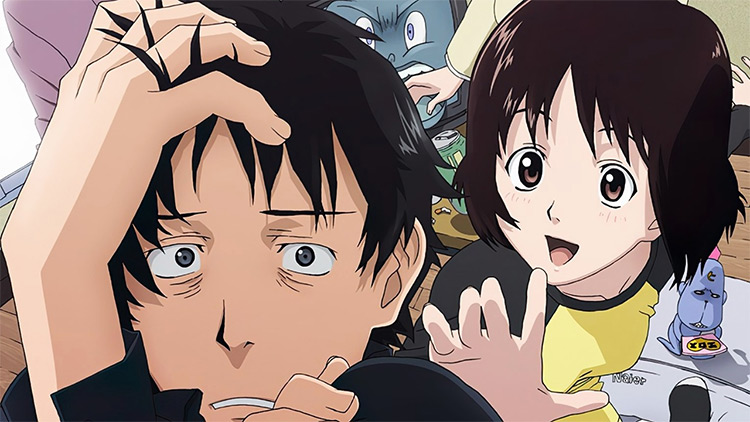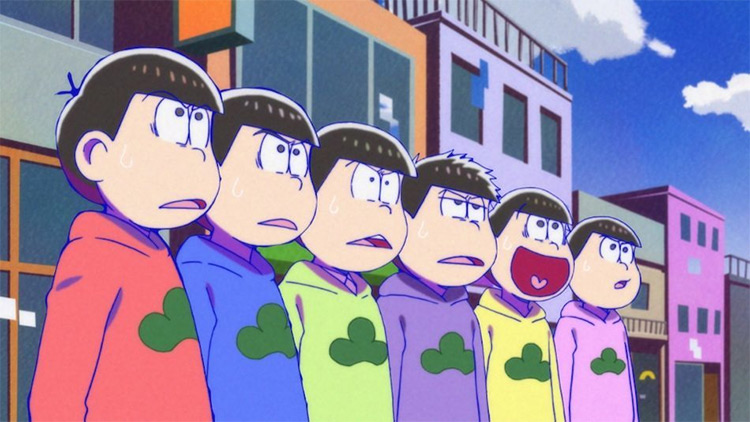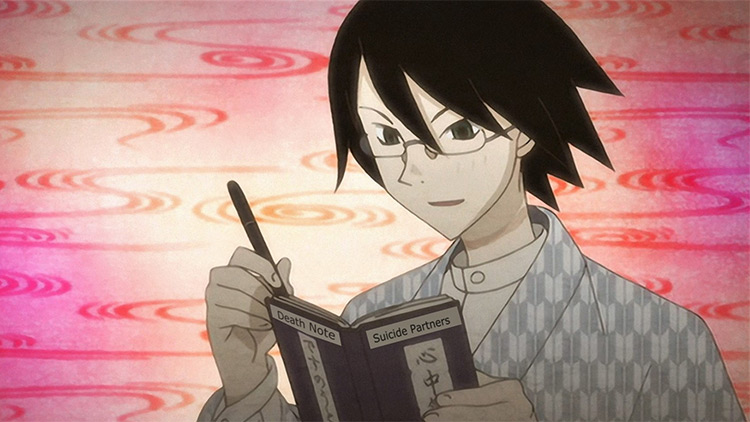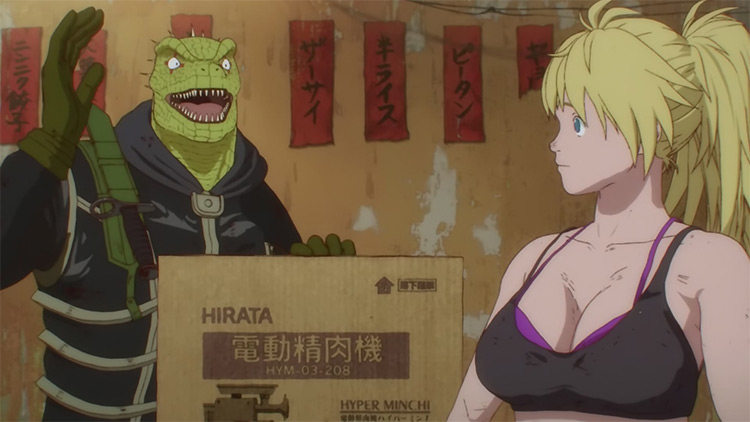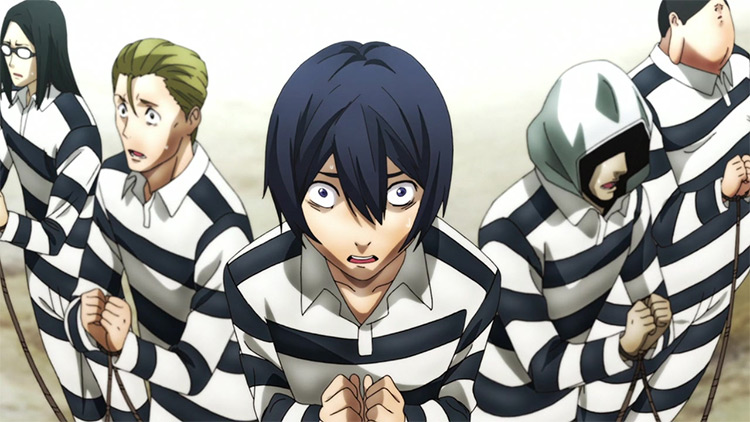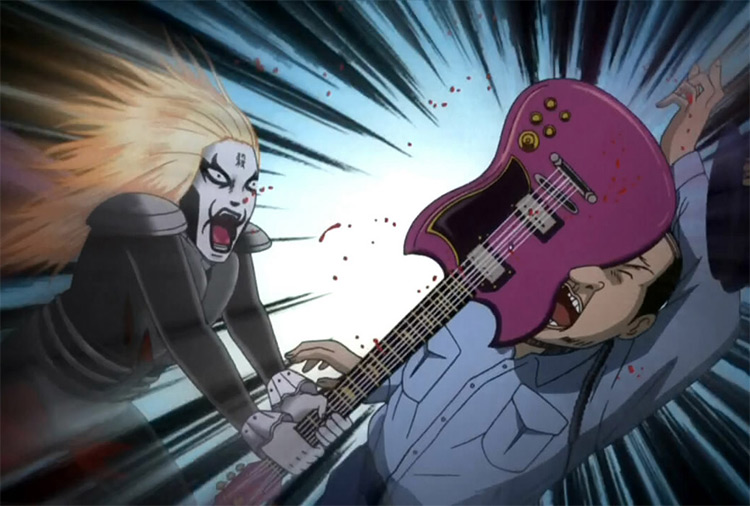This is what we look for in dark humor. From depression and self-loathing to joblessness and the collapse of society, these dark comedy anime titles will remind you to cheer up even when the whole world wants you to feel down.
20. Sankarea: Undying Love
Chihiro Furuya is passionate (or perhaps mightily obsessed) about the undead. Since he was a child, this 15-year-old has always wished for nothing else than a zombie girlfriend. When his pet Baabu dies due to an accident, Chihiro becomes determined to revive the cat. Eventually, he meets the Rea Sanka, a beautiful rich girl who’s frustrated with his family and sheltered upbringing. They successfully make the resurrection elixir for Baabu, but Rea drinks it in a suicide attempt (yes, you read that right) — and turns into a zombie. Rea’s undead self moves in with Chihiro, who must now help navigate her new life despite the unknown consequences and the known risk of being eaten. Just two years after the release of Warm Bodies, the anime world responded with its own story about a human and a zombie striving to coexist and perhaps fall in love. If you like that book (or the film) and ecchi rom-com, Sankarea is for you.
19. Gintama
Samurai are cool, but Gintoki Sakata’s world has evolved past the need for them. Still, the silver-haired MC embraces this identity as he runs Yorozuya, a business that takes on any job no matter how crazy or questionable. Assisting him are Shinpachi Shimura and Kagura. Shinpachi is a samurai wannabe who was framed by Gintoki early on — and his sister was nearly sent to a brothel. As for Kagura, she’s accidentally killed many pets due to her strength. Thankfully, the big head-biting dog Sadaharu can tolerate her deadly hugs. Also, there are aliens, a guy who will accept any job to finance his terrorist plans, and a nicotine-addicted official who pressures others with seppuku. Gintama is a modern classic of comedy anime. However, it sits only at this spot because its comedy does not specialize in dark humor. There’s plenty of it here, but it’s scattered across over 350 episodes.
18. Magical Witch Punie-Chan
In Magical Land, the citizens await the day when the next queen is crowned. For now, Punie Tanaka has transported herself to Earth. Specifically, the queen-to-be is studying at a school in Japan as part of the mandatory training for nobles. Punie exudes an inviting and friendly aura, especially with her beautiful short blonde hair and cute dress. Unfortunately for anyone who irritates her, she can immediately switch her demeanor. If she doesn’t use her magical stick, she’ll violently discipline them through wrestling. Furthermore, her animal companion Paya Livingston has thought of backstabbing her more than once — and many others back in her kingdom are intent on bringing her down. There’s no meaningful depth in its story or characters – and that’s exactly why it works. For eight episodes (this includes the special), Dai Mahou Touge is just a hilariously violent anime that will help you destress after a long day.
17. Life Lessons with Uramichi-Oniisan
Uramichi Omota is part of a children’s TV series featuring bright-eyed preschool kids with big smiles. But all this positivity and youthful energy don’t stand a chance against the darkness in Uramichi’s weary and pessimistic heart. Each time a child happily asks about life, he can’t help but crush their optimism with the cruel reality of adult life, which he has personally endured (mostly with the help of vices like chain-smoking and alcohol drinking). Apart from him, Life Lessons with Uramichi-Oniisan has other ‘amusing’ adults. Iketeru Daga easily gets into a fit of laughter from the most childish dirty jokes while Utana Tadano struggles to be successful as a singer and is desperate for marriage. If the sheer contrast between happily innocent children and cynical adults isn’t enough to hook you in, consider the voice acting. Everyone does a stellar job to bring life to the manga’s signature dark humor, with the revered Hiroshi Kamiya (Levi from Attack on Titan) leading the way as the MC.
16. Plastic Neesan
The third-year Iroe Genma leads the school’s [Plastic] Model Club, joined by the hot-tempered and brutal Hazuki Okamoto and the more reasonable Makina Sakamaki. All three girls want to accomplish their plans for the club. But each time, they’re distracted by ridiculous circumstances. On the bright side, the diversions highlight their chemistry and talent in slapstick comedy. Plastic Neesan is one of the strangest anime projects. There’s weird humor, yes. Yet what’s most odd is that this seinen was produced by Good Smile Company, the one and only manufacturer of Figmas and Nendoroids. Anyway, you can watch this in one sitting since all 12 episodes are just two minutes each. Plastic Neesan maximizes its limited duration to focus on landing the joke right from the start. And if you’ve seen the infamous video of a baseball team captain who likes to wear a bra and panties in public, you’ll be happy (or disgusted) to learn that he’s here.
15. Bludgeoning Angel Dokuro-chan
In contrast to Gintama, Bokusatsu Tenshi Dokuro-chan is just a four-episode OVA with an even shorter sequel. And from the title, you can already guess that it involves physical violence led by a divine entity. So why will an angel assassin barge into Sakura Kusakabe’s life anyway? Well, he’s destined to anger God. In the future, Sakura will invent a tech that will prevent girls from maturing after they reach 12 years old, leading to a loli world. His real sin is that his tech will also turn them immortal, which goes against God’s design. Instead of killing the young Sakura, Dokuro chooses to make his life a living hell. If she incessantly teases him and locks him in a cycle of being murdered and resurrected, Sakura won’t have the time or peace of mind to complete his grand vision. Bludgeoning Angel Dokuro-chan goes all-in when it comes to bloody humor. There’s even Binkan Ichiro, the celebrity guy who proudly exposes himself in public and reaches a sexual climax with a light touch.
14. WataMote
Tomoko Kuroki is ready to make waves in high school. Aside from making friends, she’s excited to find a boyfriend. Plus, Tomoko has dated more than a hundred guys and boasts incomparable knowledge about living life. So what’s the catch? Well, her expertise in love and life hail from the digital world — all those boyfriends only exist in dating video games. Tomoko is a huge and stereotypical otaku. Her social circle is nearly non-existent and her highly introverted and awkward personality prevents her from putting plans into action. Does she really have what it takes to come out of her shell? Maybe she does, particularly with help from her younger brother and her friend, both of whom adapted way better to growing up. Also, you’ve been warned: You’re likely to suffer from secondhand embarrassment many, many times.
13. You’re Being Summoned, Azazel
Azazel is an exquisite name. Sadly, it’s gone to waste because the bearer is a pathetic devil and the living embodiment of lust. As Akutabe and Sakuma Rinko summon Azazel Atsushi to help with detective work, they quickly realize he’s more of a problem than a solution. Every arc across two seasons reminds viewers that the MC is a massive pervert with no redeeming factor. Sheer incompetence is one thing, but Azazel also ruins Rinko’s daily life with harassment. It’s no wonder why he’s always subjected to her righteous anger and Akutabe’s sadistic tendencies. Moreover, all other demons have their own disgusting and depraved traits. From deadpan deliveries and savage slapstick to gross humor and blasphemy, Yondemasu yo, Azazel-san is a hotpot of craziness executed with above-average music, voice acting, and animation.
12. Hozuki’s Coolheadedness
The oni MC Hoozuki is the ever-reliable assistant of the king of hell and the antithesis to Azazel Atsushi. He’s smart, but also incredibly strong. If professionalism isn’t enough to keep everything under control, he won’t think twice about resorting to physical and emotional cruelty. Essentially, Hoozuki no Reitetsu is a workplace comedy that trades office drama in high-rise buildings for bureaucratic troubles among mythical creatures. It’s fun whether Hoozuki is outwitting others or giving them his own brand of hell with his enormous metal club. So if You’re Being Summoned, Azazel isn’t your cup of tea, but you still want a series with demons and a lot of barbaric punishment, Hozuki’s Coolheadedness should be on your PTW list.
11. Excel Saga
Excel and Hyatt have one mission: Place Fukuoka City under the control of the ACROSS leader, Il Palazzo. Sadly for Il Palazzo and the entirety of ACROSS, the two girls can never get the job done. If anything, all they ever achieve is utter chaos and bloodshed. Excel and Hyatt are so terrible that the hilarious-looking The Great Will of the Macrocosm must interfere to bring them back to life and reset the story. The first 25 episodes are vintage offerings of seinen dark comedy that are unashamed of being largely senseless. There’s even a guy who gets killed due to Excel’s incompetence, becomes resurrected, then comes back home to discover that his family had already forgotten about him. And if you want the best (or worst) of Excel Saga, watch the 26th episode. Appropriately titled Going Too Far, it was consciously made to be so perverted and profane that no network dared to air it on Japanese TV.
10. Humanity Has Declined
Rather than rely on random and loud hilarity, Jinrui wa Suitai Shimashita pursues dry humor and packs episodes with commentaries on the perpetual ills of human society. Yet despite its satirical and cynical writing, it never feels too ‘cerebral’ for general viewers to not enjoy. How does it achieve this balance? First, Humanity Has Declined is set in a future where highly advanced faeries have taken over Earth and the remaining humans are at their mercy. Second, these adorably small creatures and the overall show are drenched in a bright and colorful art style. Thus, there’s a satisfying contrast between the light visuals and dark themes. And the MC embraces this design as well: Watashi’s smile, pink hair, and cute dress conceal her deadpan delivery and occasionally negative mindset. Only in this unique fantasy adventure will you find unsustainable consumerism, deadly candy addiction, and bread suicide.
9. Black Lagoon
Rokurou Okajima has lost his drive and found everything boring and repetitive. Then his life takes a 180-degree turn when Black Lagoon kidnaps him and his company opts to ditch him instead of paying a ransom. From a tired businessman, Rokurou becomes the new member of the mercenary group. Along with him are a super muscular Christian veteran (Benny), a Jewish college dropout (Benny), and a hot-headed and sadistic woman (Revy) who grew up stealing and killing. The MCs are fantastic here – and the same applies to other characters. Roberta is a gorgeous bespectacled maid who once killed helpless children and adults. There’s also the pistol-wielding Yolanda from the Church of Violence. If Quentin Tarantino wrote and directed an anime series, it would most likely have the same adrenaline and edginess as Black Lagoon. It’s the rare kind of comedy that arises not from basic slapstick and jokes but the outrageousness of otherwise serious and grim situations.
8. Joshiraku
Joshiraku is a slice-of-life anime about rakugo girls talking about anything under the sun. So is it another predictable CGDCT series? You can classify it as such, but Rakugo Girls sets itself apart with its variety of topics. Yes, these five dear friends look cute. But their conversations aren’t limited to wholesome and adorable things. There’s even one episode that talks about politics and has a parody of a Japanese prime minister. Of course, what truly sells Joshiraku are the characters. In particular, the dark comedy exists because of Gankyou Kuurubiyuutei and Kukuru Anrakutei. Gankyou loves books, the Internet, and being hostile to her friends. On the other hand, Kukuru’s humor is laced with darkness and negativity — and her name itself alludes to terms like euthanasia and anguish. There’s never any dull moment with these five girls. It’s a testament to JC Staff’s competence in adapting the series and to the strength of mangaka Kouji Kumeta’s unique storytelling.
7. Oruchuban Ebichu
Did you know that the studio behind Neon Genesis Evangelion was behind this? That’s right. Somehow, Gainax made time for Ebichu Minds the House, a 24-episode ecchi seinen about a pet hamster, her office lady master, and the OL’s terrible partner. Ebichu is certainly cute — and she’s even become a classic meme staple today. Still, the simple character designs and backgrounds are the anime’s only family-friendly aspects. Apart from sexual indulgence, the series embraces explicit language, Ebishu’s diverse punishments, and the pathetic but amusing dynamics of a broken relationship. With the premiere of both Excel Saga and Oruchuban Ebichu, 1999 was truly a blessed year for fans of unabashedly outrageous and lewd comedy anime.
6. Welcome to the N.H.K.
Tatsuhiro Satou is a NEET, which means that he’s an adult who’s neither working nor pursuing school or any skill to improve his socioeconomic status. This is already alarming, but the 22-year-old also believes in several conspiracies. For example, he believes that the Nihon Hikikomori Kyokai exists — a supposed organization shrouded in darkness that (also supposedly) prevents him from escaping his pitiful and years-long hikikomori lifestyle. Thanks to an accidental meeting with the younger Misaki Nakahara and her willingness to help, Tatsuhiro might finally become one step closer to becoming a better person. Still, can he succeed when the other people in his small social circle include a fellow conspiracy believer (Kashiwa Hitomi) and an ecchi-addicted hardcore otaku? Most of all, does Tatsuhiro have it in him when his headspace is far from okay? Welcome to the NHK is a mix of serious and fun episodes and has more drama than most entries. Yet this is also what I’d call S-tier dark comedy. It tackles depression, social isolation, suicide, paranoia, and other serious matters in a way that makes viewers laugh, cry, and contemplate their life all at the same time.
5. Osomatsu-san
People say that you shouldn’t judge a book by its cover. In Studio Pierrot’s Osomatsu-san, there’s really no point in judging the six Matsuno brothers by their appearance – because they’re practically the same. Furthermore, the siblings have a shared lack of urgency to be responsible adults. They’re already in their 20s but none are employed, pursuing a meaningful path, or in a serious relationship. To be fair, there are occasional instances of motivation. Yet nothing works out due to their dysfunctional behavior and dynamics, which always lead to the strangest situations, often sprinkled with nasty phrases and toilet humor. Despite this series’ “newness” outside Japan, the Osomatsu-san franchise has a cultural legacy that cannot (and should not) be ignored. Even if you’re not in Japan or weren’t around when the manga debuted in 1962, you owe it to yourself to finally understand what makes these sextuplets special yet awfully, charmingly relatable at times.
4. Sayonara Zetsubou Sensei
Next to parents, teachers are often idealized as the most important adults in children’s lives. They enrich and expand the youth’s understanding of themselves and the vast world around them. Unfortunately for Nozomu Itoshiki’s students, he leans more into a life of fear, cynicism, and darkness — and he’s tried to kill himself many times. Of course, the satire and offbeat humor of Sayonara Zetsubou Sensei work because of the students as well. For example, Kafuka Fuura treats suicide as a way to gain height because she’s obsessed with unhealthy optimism. Another student, Chiri Kitsu, keeps sharp objects in her bra. There’s a hikikomori who lives in school, a panty-hating illegal immigrant, a practically mute girl who’s hostile online, and a bandaged girl who keeps touching animal tails despite all the injuries she incurs. Goodbye Teacher Despair is arguably the most beloved anime adaptation of a Kouji Kumeta manga — and for a good reason. His writing prowess elevates this dark comedy above most others, and Studio Shaft’s distinct style ensures that all three seasons receive worthy visuals, animation, and direction.
3. Dorohedoro
The incomprehensibly bleak and brutalist district of Hole is at least two things. For many, it’s their home despite the chaos. But for those imbued with magic, Hole is where they can find hapless living beings to exploit, torture, and kill. However, not everyone in the area is deathly afraid of sorcerers. In particular, Caiman is immune to magic and loathes its wielders. Why? One of them caused his reptilian curse. He doesn’t know who did it due to his amnesia, so he questions every magic user he comes across and typically murders them once he gets an answer. Daily life in Dorohedoro includes rampant death and violence. Rather than coming off as laughably edgy, the show remains thoroughly engaging and artistically superior because of its creativity and complexity. And when there’s no killing involved, you’ll find the characters from each opposing side joke around and get drunk. This series can be joyous, hardcore, and unsettling all at the same time. I applaud Yuiichirou Hayashi for taking on this adaptation when others thought that the manga was too intricate to turn into an anime.
2. Prison School
Here’s the gist: Five boys enter the historically all-girls Hachimitsu Private Academy. Expectedly, the girls refuse to give them attention. And when their plan to spy on naked schoolmates is foiled, they’re thrown into prison for a month under the watch of the notorious Underground Student Council. From there, Prison School dishes out unrestrained humor and erotic slapstick. The overly detailed faces and passionate voice acting (including Hiroshi Kamiya as Kiyoshi Fujino) ensure that all the sweat, tears, blood, urine, and other bodily substances coming out of the characters extract the loudest laughs from the audience. Everyone plays their role to perfection. Specifically, I applaud the simple yet effective comedy of Reiji Andou’s bizarre face and masochism, Maiko Shiraki’s man-hating attitude and impossibly voluptuous figure, and Jouji Nezu’s bloody coughs and potty mouth. Look, sustaining and upping the craziness factor aren’t easy since EP 01 set the bar high. Yet the anime amped the lewdness, sadomasochism, and gross-out gags with each new episode. Prison School is an instant-classic comedy anime, and a much-deserved second season is way overdue.
1. Detroit Metal City
Souichi Negishi is a sweet and gentle guy from the countryside who likes soothing and soft pop music. He’s finally achieved his goal of becoming a successful musician, but only as Johannes Krauser II, singer and guitarist of the titular underground death metal band. Hardcore fans of the band think that Krauser-san ascended from hell and has committed countless acts of murder and sexual violence — and they expect more. The DMC manager, Jagi, likes getting high, drinking, smoking, and swearing in English, and the otherwise meek drummer is no better. Moreover, Negishi’s identity crisis never bodes well for his crush Yuri Aikawa and his friend (and fellow musician) Hideki Saji. There’s a ton of swearing, spitting, and bloody mayhem, none of which the true Souichi would condone, much less do himself. Unfortunately, he doesn’t have a choice. If you’ve seen both Prison School and Detroit Metal City, you’ll understand when I say that I had a hard time deciding which one’s funnier and more demented. In the end, the latter won me over not just with its unrepentant and consistently dark humor, but also with its unconventional and pleasantly “rough” art style and animation. Normally, a shorter runtime is a disadvantage. In this OVA, it becomes a significant factor in effective comedy: Each episode is only 13 minutes long, so there’s this palpably hurried storytelling from the dialogue to transitions. It’s like the show is playing at 1.5 times the normal speed, which makes it more hilarious. Stories focused on someone living two strikingly different lives isn’t new in comedy anime, but Detroit Metal City takes the crown for doing the most out of the visual and behavioral contrast. It’s a cult classic – and another stellar addition to director Hiroshi Nagahama’s stellar portfolio.
